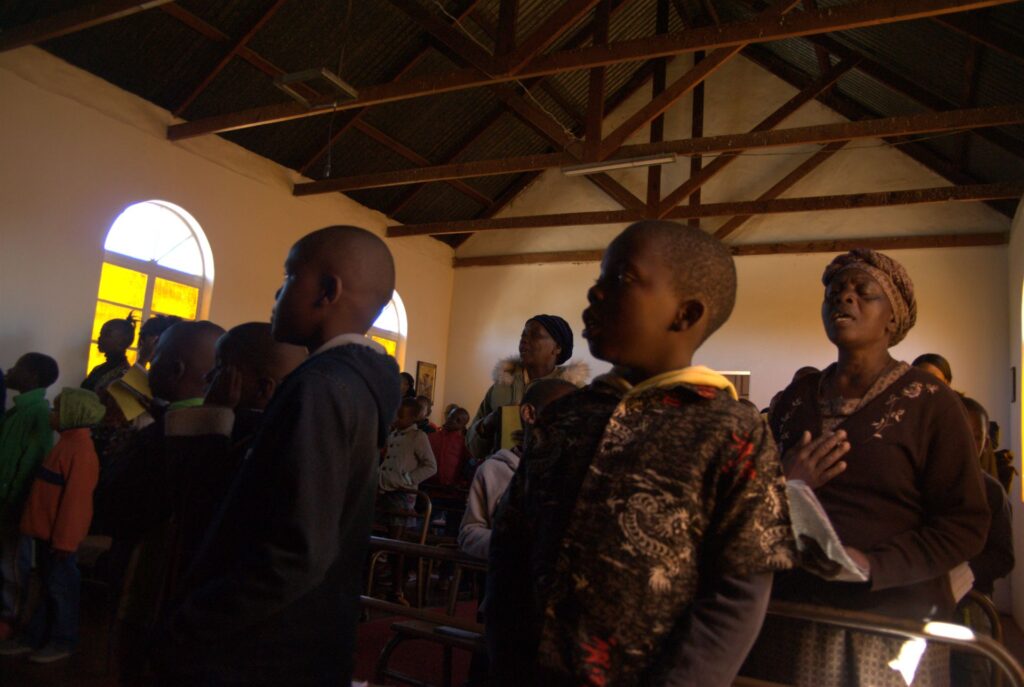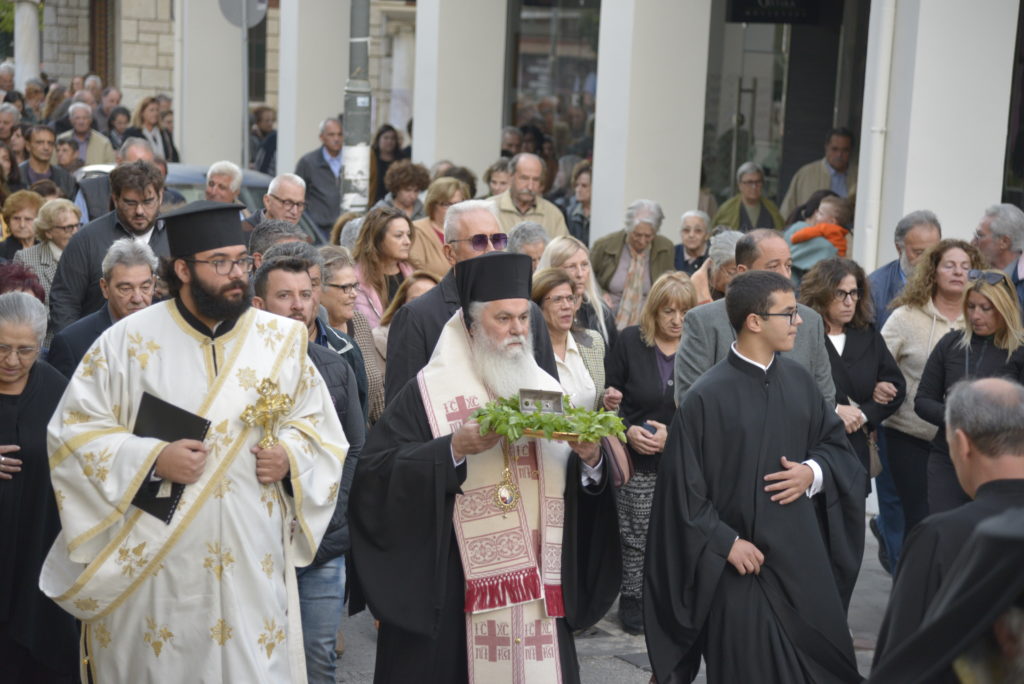Orthodox church in Zimbabwe keeps flame alive with Greek community support

Orthodoxy is alive and well in a distant African township
The churchgoers’ response to Fr George Glafcoss is immediate and their singing is spontaneous and continuous. The sound of the many voices rises above the rafters and seems to lift the bare corrugated roof.
This service in St Augustine’s in a township of Bulawayo, Zimbabwe’s second city, is Orthodox but the celebration of the liturgy is vibrantly African.
The congregation does not only listen to the priest and his assistants but is very much part of the process singing the responses in loud, enthusiastic voice so different from the Byzantine form in traditionally Greek services. Fr Glafcoss, whose civil name is Proud Sibanda, was baptised and grew up Orthodox and serves at St Augustine’s, which is in Mzilikazi, a traditionally black township, but also leads services at St John the Baptist, the parish church of the Greek community in Bulawayo’s city centre.
“I am at St John’s on the big feast days, sometimes I do individual services such as memorial services, baptisms or services for the sick. I give communion or go to bless businesses and homes.
“I can do the whole service in Byzantine Greek, from start to end, but I can also carry out services in English as well as in Ndebele and Shona, the indigenous languages of Zimbabwe,” said Fr Glafcoss.
The priest, with help from his Reader and others in the community, translated the Divine Liturgy into Ndebele.
“The translation had a profound effect as it made it easier for the congregation to understand the terminologies and relate to what is going on during the service. The liturgy is correct and it is Orthodox even though it is different to Greek church practices.”
Thanks to the translation, it became easier to participate in the services and participation of the congregation is essential in an African service.
“In Mzilikazi there are psalters who lead and congregants follow but they follow different rhythms to the Byzantine rhythm. It is difficult to follow Byzantine music and to sing in the priest’s tone, you cannot just join in. It needs time to learn that type of singing.”
The church in Mzilikazi was built in 1958 and was affiliated with the African Orthodox Church which had its headquarters in the USA.
Fr Glafcoss’ parents were Orthodox and he grew up under the roof of St Augustine’s. When the bishop appointed by the American church died, the Greek community of Bulawayo took a hand in supporting St Augustine’s. Peter Leondios, the President of the Hellenic Community of Bulawayo and Districts for the past 29 years, said he first heard of St Augustine’s in 1995.
“When Parthenus III, the Pope and Patriarch of Alexandria and All Africa, came to Bulawayo in 1996, I told him about the church in the African township and we discussed ways to bring the church under the Greek Orthodox church. In 2001, the township church received full support from Archbishop George of Zimbabwe and Angola, as well as Bulawayo’s Greek community.
“St Augustine’s had no iconostasis and other important aspects were not in place. With the former mayor of Bulawayo, Mike Constandinos, we made contact with the church,” said Mr Leondios.
Mr Leondios paid for the iconostasis to be brought over from Greece and was dedicated in honour of his late parents.
A large baptismal font was built outside the church and this has seen the baptism of over 500 Orthodox members from Mzilikazi and the surrounding townships.
The adjacent church hall was built and a kitchen and a computer room and ablution have been added with help of the Greek community of Bulawayo.
“Much of the work has been done with the support of the Metropolitan of Zimbabwe, the archbishop also pays the school fees for many of the children attending St Augustine’s,” said Mr Leondios.
Abednico Moyo, the Reader and chairman of the St Augustine Church committee also grew up in the church.
“We have a lot of orphans who we support through school with help from the Archbishop of Zimbabwe and the Greek community. We visit the sick and the elderly. Things are not as rosy as they used to be. There are a lot of difficulties.”
Problems facing the church
Support for the church started drying up when Greece became a victim of the Global Financial Crisis in 2008. In Zimbabwe itself, the economic situation is deteriorating with high inflation starting to rear its head again.
Prices are soaring while incomes remain static and unemployment is over 90 per cent. The orphans that the church supports are the victims of the high number of Aids sufferers in a country which can’t afford to spend less and less on health care and social support.
“Our kids now need books and writing materials which we used to get in plenty when Greece was alright.
“Many of the children stay with aunts and grandparents. We are constantly providing for food, shoes and school uniforms and Fr Glafcoss often gives from his own pockets,” said Mr Moyo.
“The biggest problem is the transition from Junior to High school because the fees suddenly become much higher. I recently paid for five children,” said Mr Moyo who is a pensioner.
“Our liturgy books, which we translated into Ndebele, are photocopies and we need properly bound books that last much longer.
“Many people in the area are Roman Catholic and they are not lost when they come to our services. They want to know about us and how the churches went their separate ways. We often bring one old Roman Catholic lady to our month-end liturgy.”
Part of the problem is that the economic situation has forced many of the church’s most economically viable members to leave Zimbabwe to find work in neighbouring countries. Fr Glafcoss said the Archbishop of Zimbabwe supports up to 60 children in the parish.
“We do have contact with the other Christian churches in the area. We do meet and visit the elderly and the sick as part of community projects. We also hold seminars for youths and on the dangers of drugs. We meet to find ways to help children to stay in school.”
Fr Glafcoss said he became active in the life of St Augustine’s at a young age when the church was adopted by the Greek community in 2001.
“I can’t say when exactly I decided to become a priest, it happened gradually. When I finished high school, Archbishop George Vladimirou sent me to St Athanasius Seminary in Alexandria in 2007. I became a priest in 2011. I have served St Augustine’s since that time,” he said.
“Sometimes people come to funerals and are impressed by the singing and the liturgy and want to know more, some are attracted by our work in the community, others are educated through the church and remain with it. Ultimately, they are attracted by the church’s message.
“I serve both the white and black Orthodox communities of Bulawayo. The church is Orthodox and it belongs to God.”
— Source: neoskosmos.com
H αναδημοσίευση του παραπάνω άρθρου ή μέρους του επιτρέπεται μόνο αν αναφέρεται ως πηγή το ORTHODOXIANEWSAGENCY.GR με ενεργό σύνδεσμο στην εν λόγω καταχώρηση.
Ακολούθησε το ORTHODOXIANEWSAGENCY.gr στο Google News και μάθε πρώτος όλες τις ειδήσεις.


















